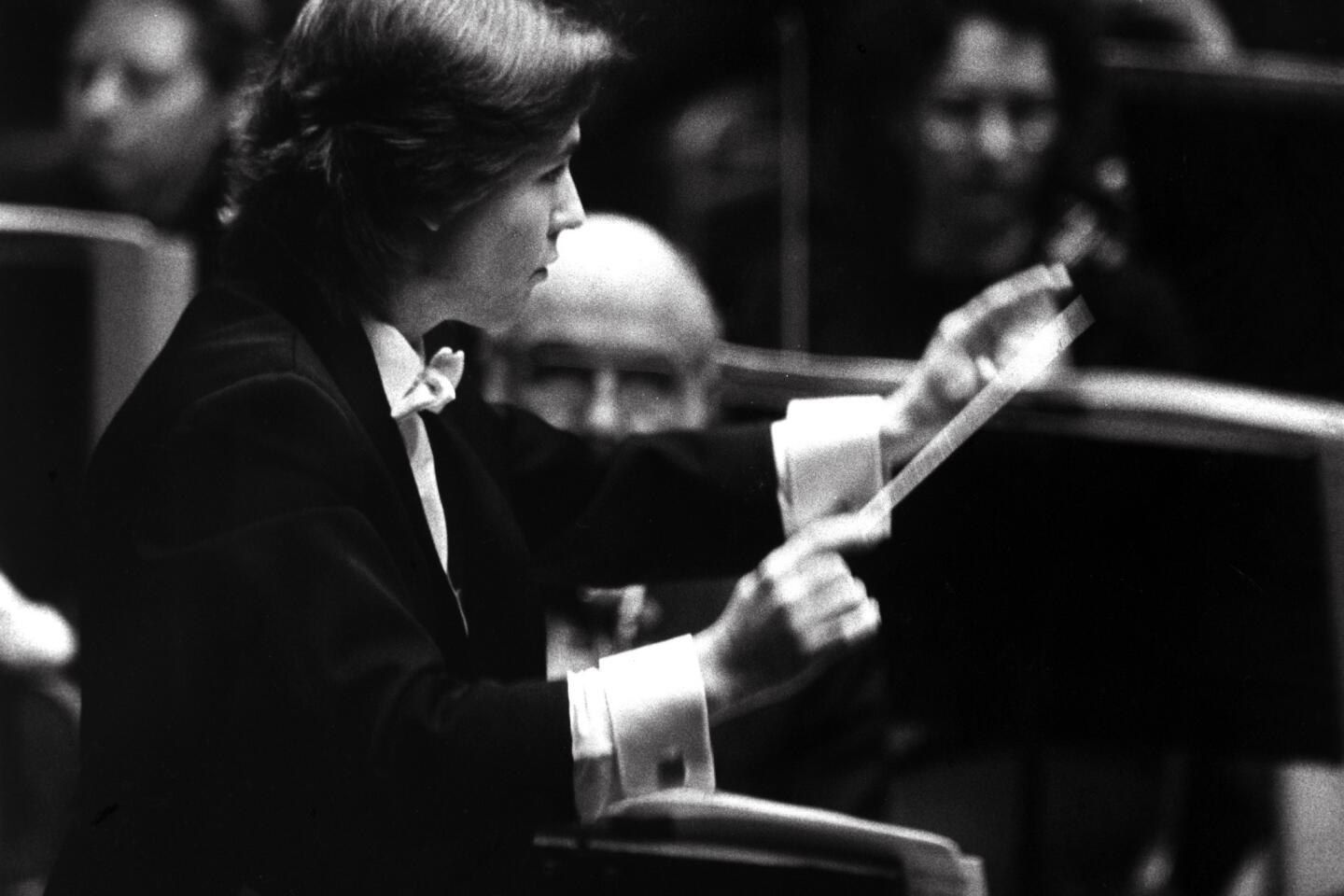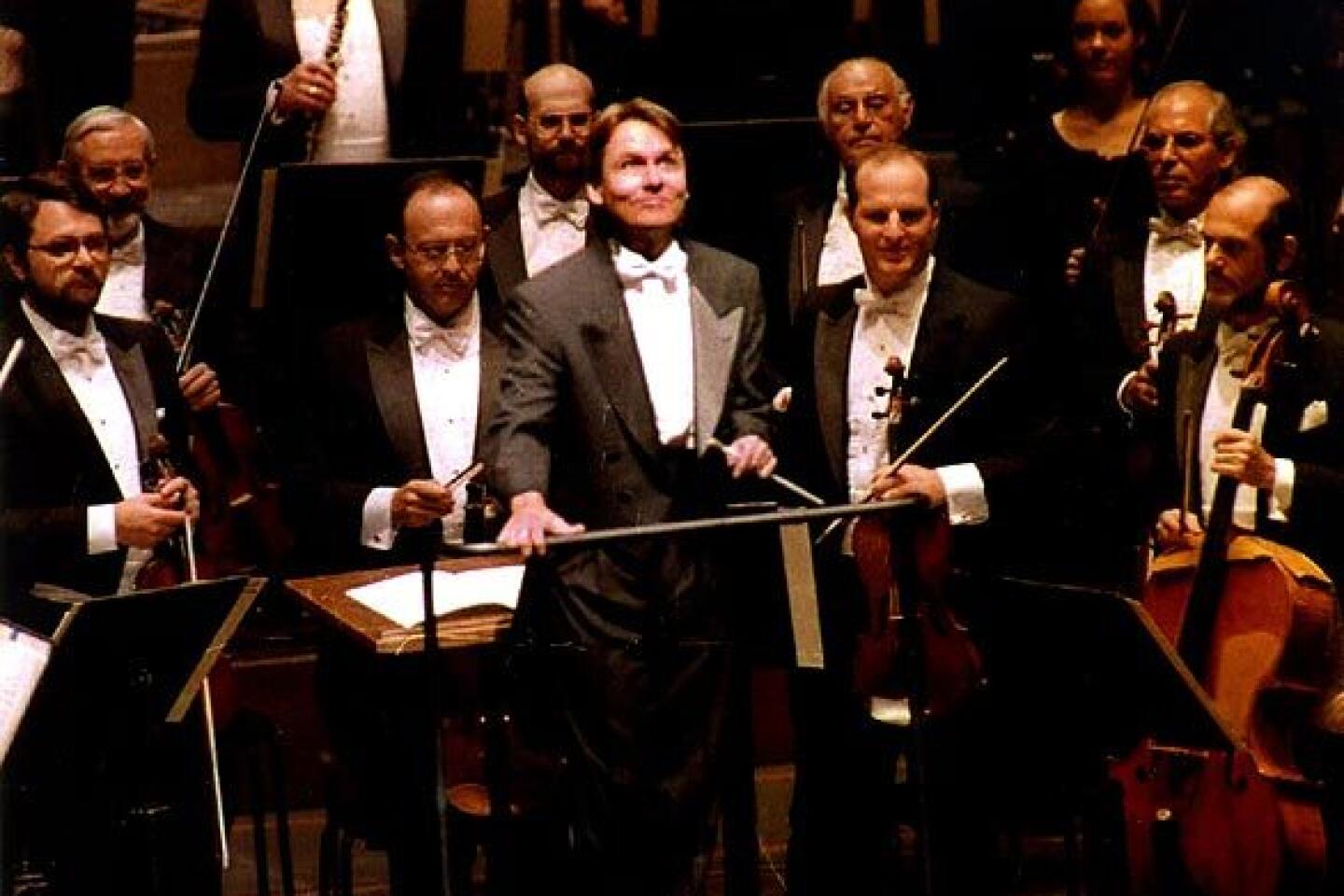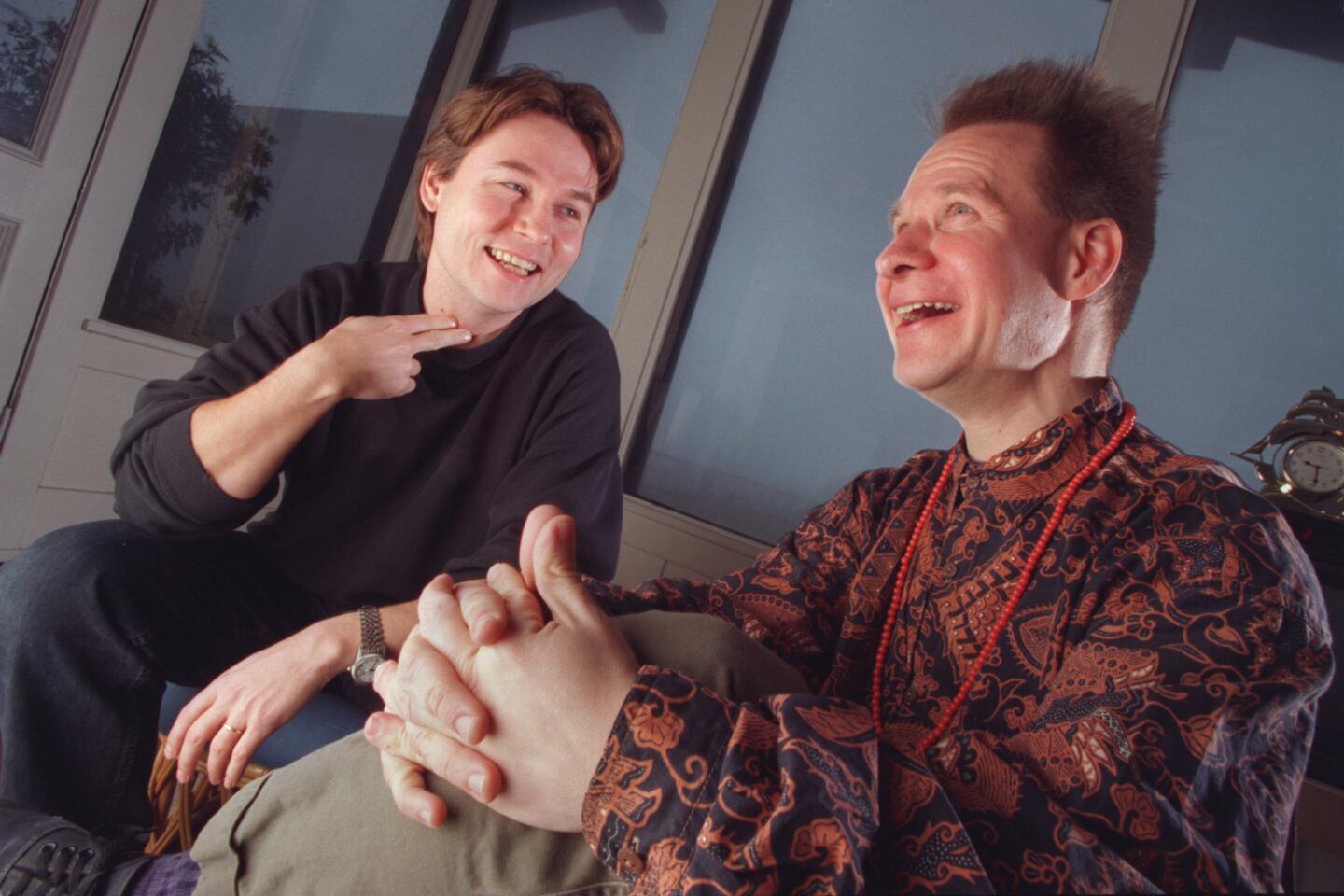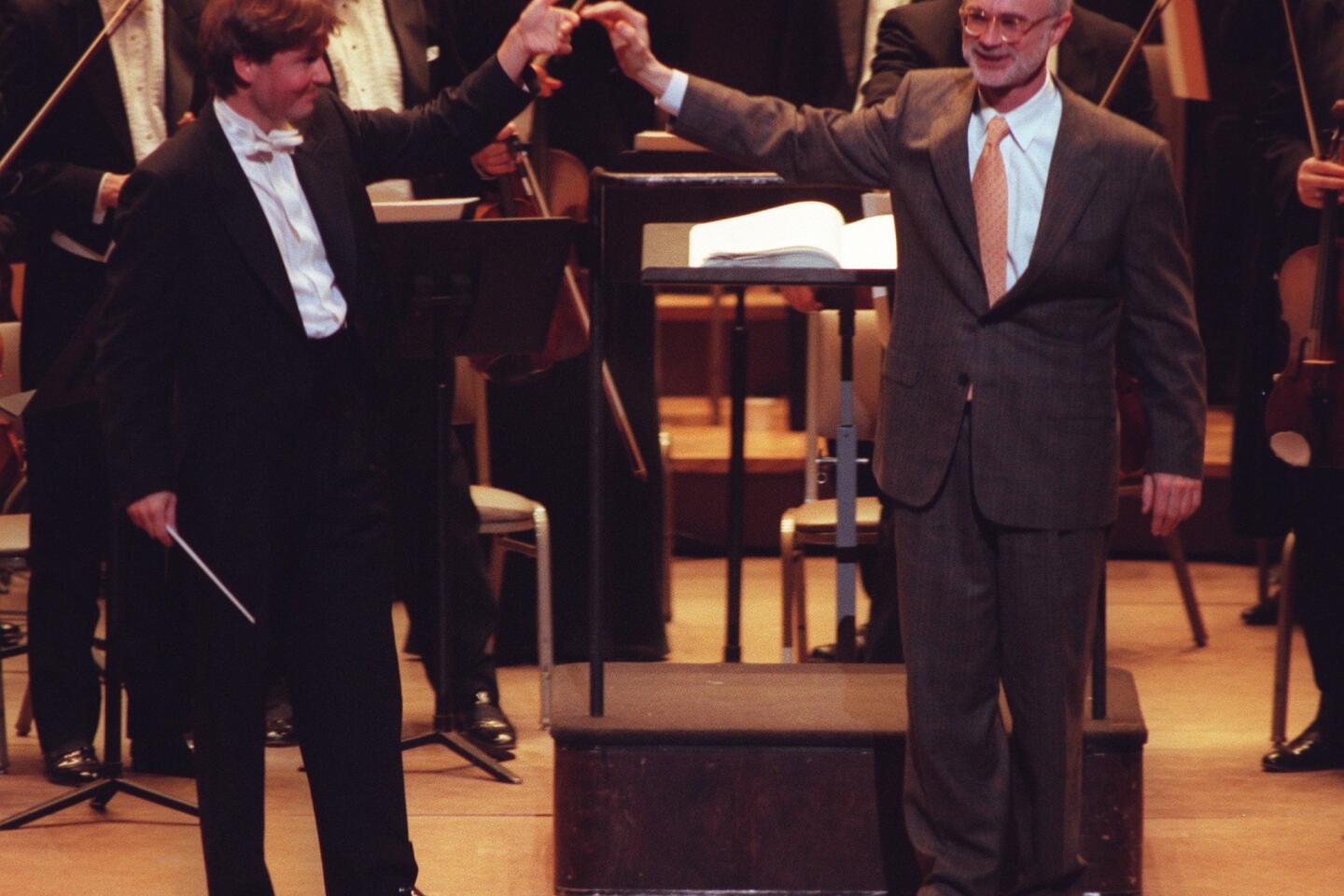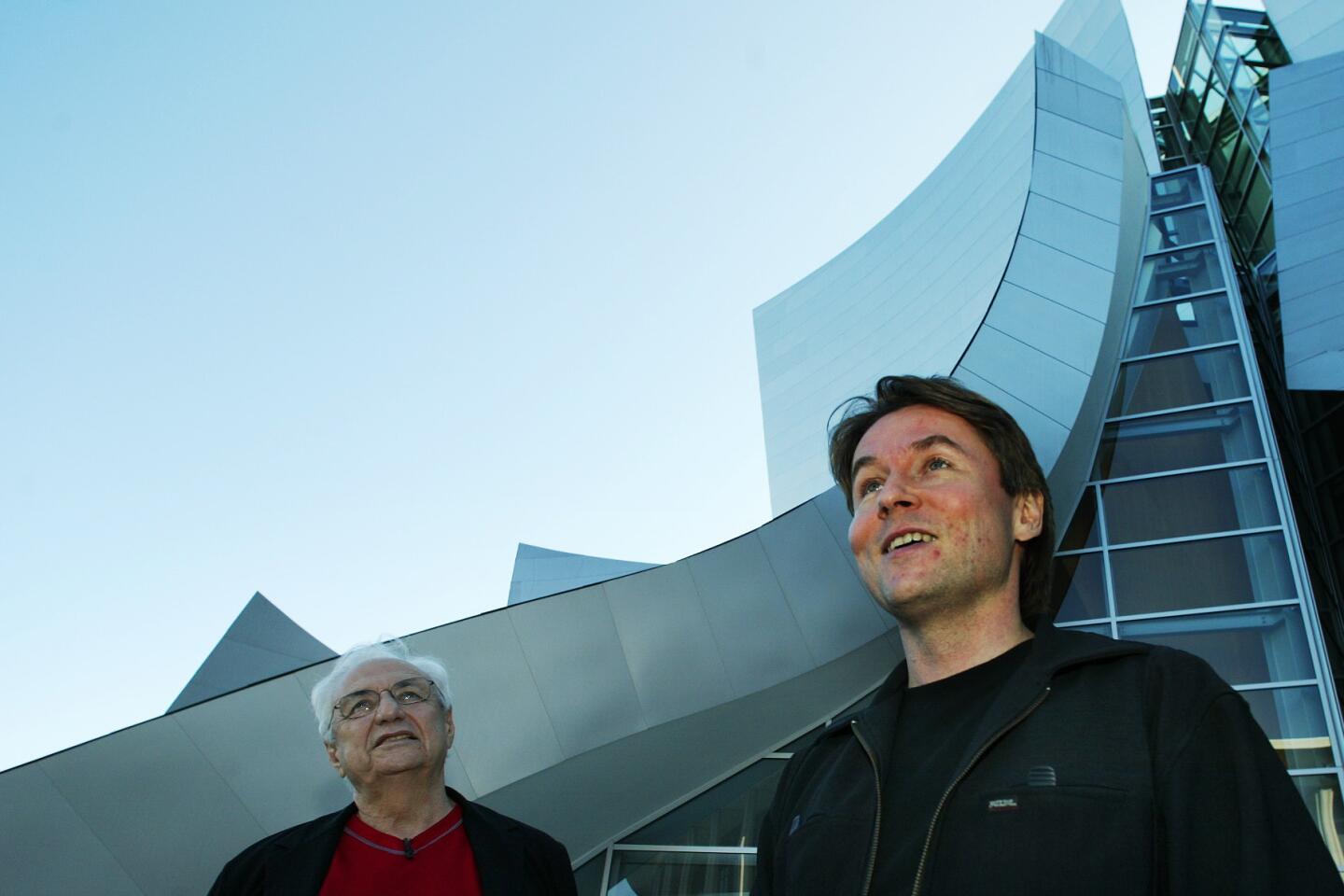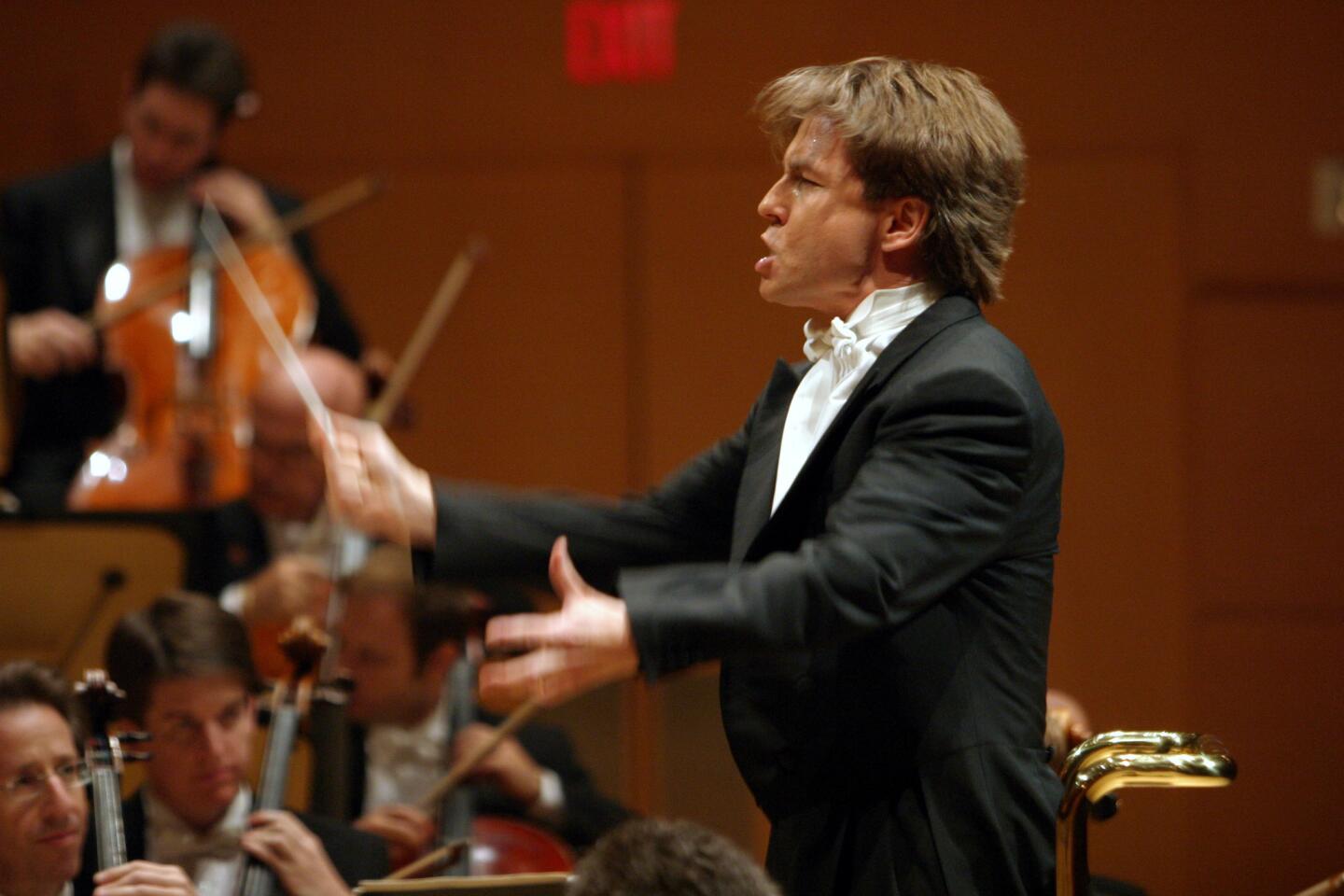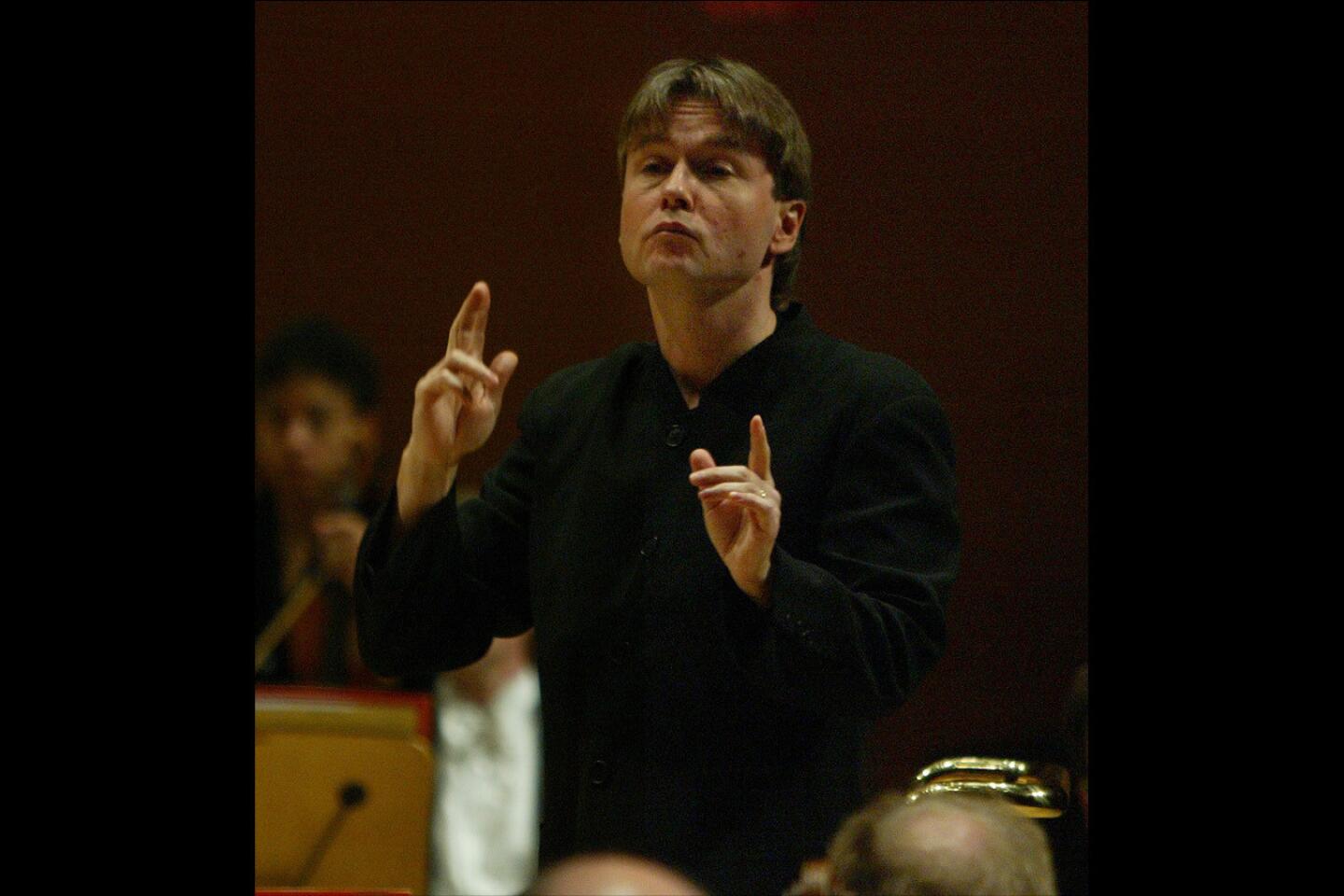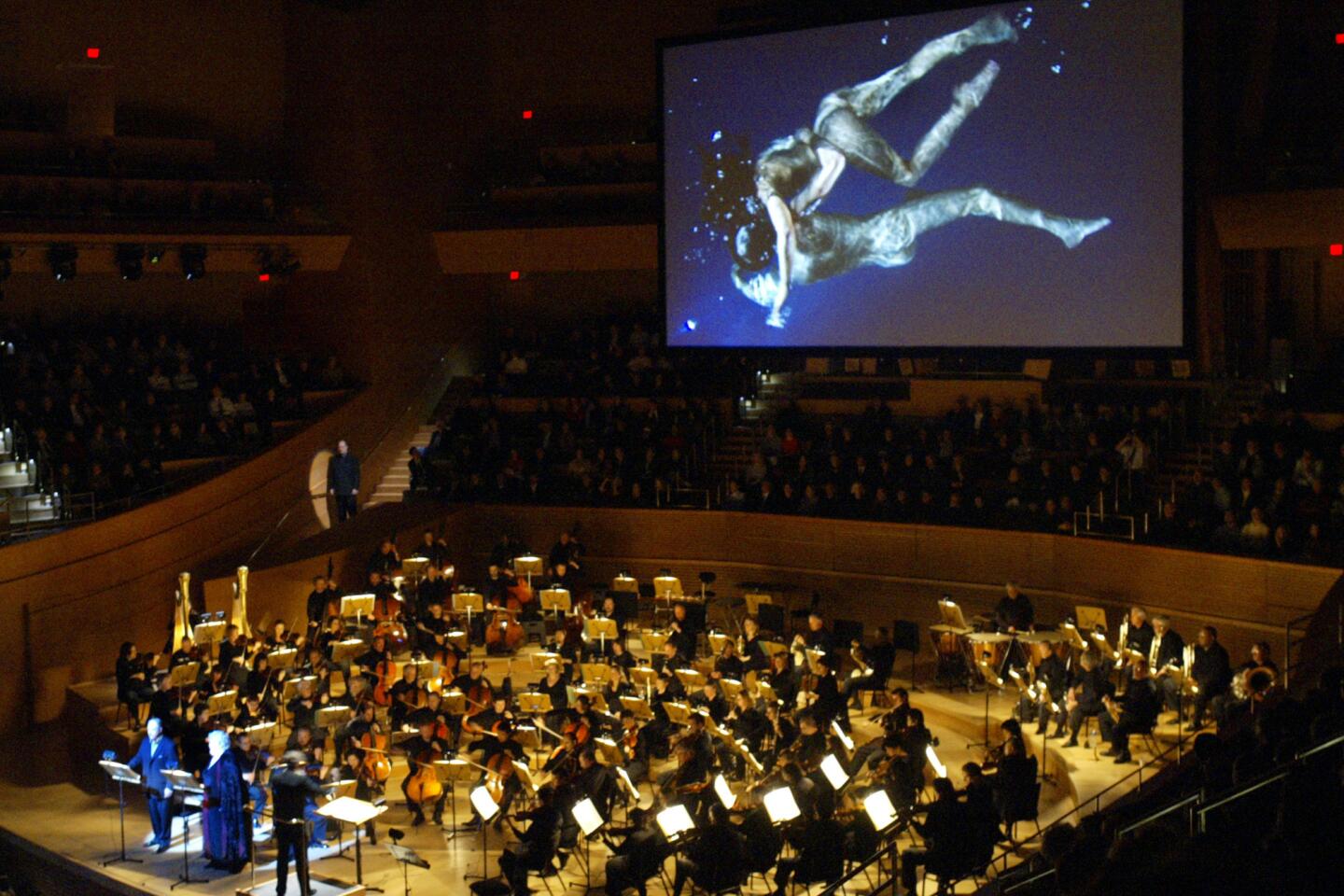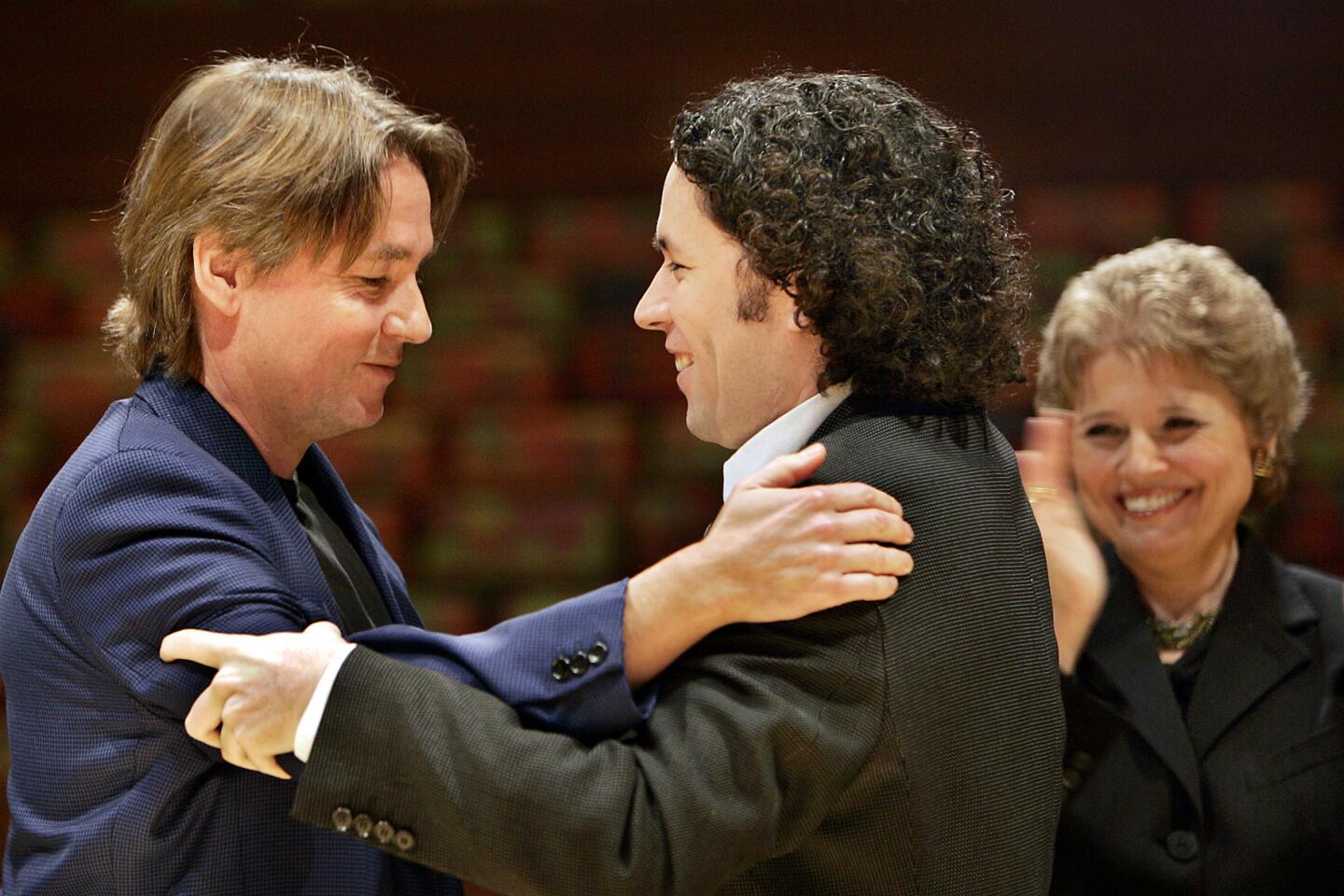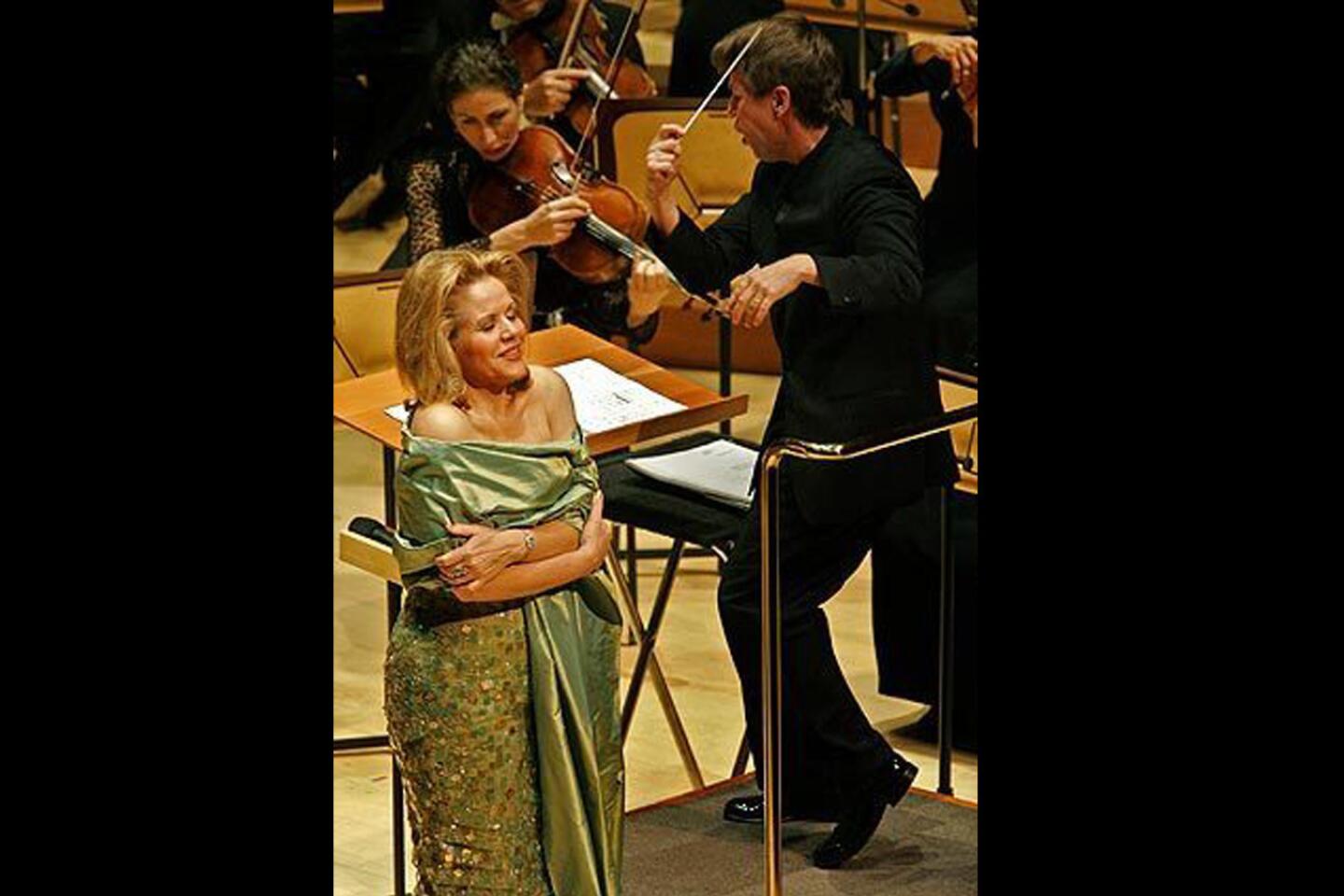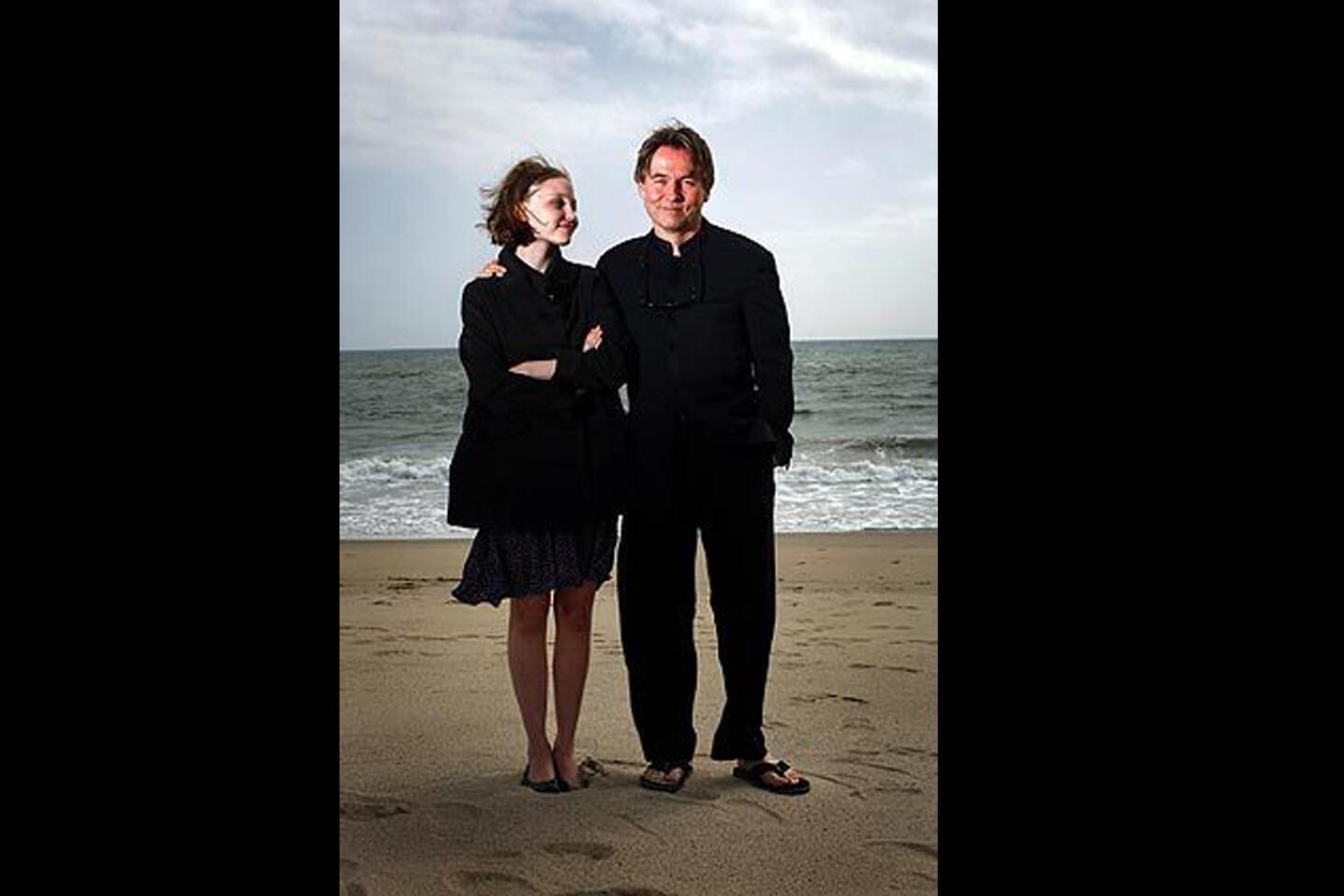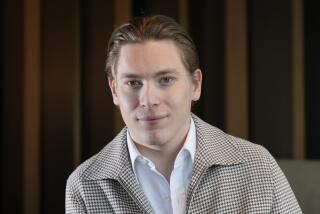In a tumultuous world, conductor-composer Esa-Pekka Salonen is focusing more on the present

Drinking a triple cappuccino on a summery morning at a Brentwood Country Mart courtyard once favored by Schoenberg, Esa-Pekka Salonen appears content. A week earlier he had returned to Walt Disney Concert Hall for his annual visit with the Los Angeles Philharmonic. The program — a Beethoven Concerto and a Mahler Symphony — was unusually conventional, at least for a venturesome conductor. But there was nothing commonplace about the dazzling performances or the reception Salonen received from a jubilant audience.
April will mark the seventh anniversary of his emotional last concert as L.A. Phil music director. Ever since the ensemble he had led for 17 years was turned over to Gustavo Dudamel, every homecoming has become an event. But there seemed something more this time.
More than a year has passed since Salonen and his wife and teenage son moved back to Santa Monica after five years in London. (Two college-age daughters also returned to the U.S.)
“We’re back here,” he says, “because we realize we are happiest here and feel like we belong to the city.” Besides that, Salonen considers his relationship with his old orchestra, of which he is conductor laureate, the ideal situation.
“I come back and I see everybody,” he says. “Musicians come up to me and tell their news. The organization is doing well; the orchestra is playing well; Gustavo is doing fantastically. I do my weeks and enjoy myself. And I happen to enjoy the fact very much that I’m in very good, warm terms with Gustavo.
“I guess it’s like being a grandparent. You play with the kids and have a good time, and then you hand them back. You get the best of them,” he says, breaking out in hardy laugh. “You have no duties. You don’t have to wake up at night and change the nappies.”
That is not to say Salonen isn’t still a Finn, which means he hasn’t lost his aversion to rose-colored glasses. In a wide-ranging discussion about the state of the world, musical and political, Salonen remains acutely aware of complex and potentially devastating issues. But, he says, at 57, he also has increasing motivation to find an effective focus in his own life.
His immediate activity is the L.A. Phil’s “City of Light” project, an investigation into French music of the 20th and 21st centuries that he has been undertaking for the last two years, first with the Philharmonia, the London orchestra of which he serves as principal conductor and artistic advisor, and also with the Chicago Symphony. This weekend his program is a mixed bill of new, recent and classic French works, including an experimental performance of Ravel’s popular ballet score “Mother Goose” with contributions by Austrian installation artists Ars Electronica Futurelab. The project concludes with Debussy’s hauntingly dark and groundbreaking 1902 opera, “Pelléas et Mélisande.”
“Some years ago, I desperately wanted to get back to ‘Pelléas,’” Salonen explains. He hadn’t conducted the opera since the L.A. Phil had collaborated with Peter Sellars on a controversial production in 1995 for Los Angeles Opera. Sellars transferred the setting from a mythical forest to Malibu and included overtones of the O.J. Simpson trial, which had just begun, as well as incidents of L.A. police violence.
Salonen’s new interest in Debussy’s opera was related to his fascination with the way the beginning of the 20th century mirrored that of the 21st century. He already had a project with the Philharmonia that looked at fin de siècle Vienna. With our world changing so radically in so many ways, socially and technologically as well as politically and artistically, Salonen says he wanted to do the Vienna thing, “because it was the last gasp of the Old World.”
Of course, when you allow art to reflect the world, the connections can lead to strikingly serious business. As it happened, Salonen was in the City of Light in November, finishing rehearsals at the Opéra de Paris for new productions of Bartok’s “Bluebeard’s Castle” and Poulenc’s “La Voix Humaine” — a double bill of interior works that revolve around the psychic distress caused by social breakdown — when he returned one night to the apartment where he was staying and turned on the evening news.
“The banner came up that there was shooting in a restaurant,” he recalls. “Nobody knew what was going on.”
People in the Bataclan, the concert hall that terrorists struck, were “tweeting in real time and saying this is not a hostage situation, this is murder.”
Salonen describes Paris as like a war zone in the following weeks, he says, especially with the streets patrolled by riot police for an international climate conference.
“I really felt that the old-fashioned, enlightened liberalism was under attack, that unless we defend it, something that started with the French Revolution is going to be lost,” he continues. “There’s a realistic chance that for the first time in my lifetime, the very central principals of democracy are under threat. And some political movements I honestly did not think I would ever see in my lifetime are happening. It scares the you-know-what out of me.”
As for the production at the Paris opera, staged by iconoclastic Polish director Krzysztof Warlikowski, Salonen says that after the terrorist attacks, “we were sort of expecting nobody would turn up. Instead we had full houses night after night. I don’t want to get into the cliché of art healing and whatever, but clearly people had the feeling that they needed some kind of communal experience.”
Then back in L.A. in January, he woke up one morning to a text from the Finnish conductor Susanna Mälkki that Pierre Boulez had died. Salonen had a rebellious relationship to the French composer’s domineering influence on modern music. But Salonen is also inescapably in the Boulez model of celebrated international composer-conductor, and the news of Boulez’s death at 90 was devastating.
“It was just very hard to accept, because now it’s like our generation is it. And that’s scary,” Salonen says. “It’s bizarre that I’m almost 60 and this father figure was 90, so in a sense I feel like I have to grow up now because he’s gone.
“Also, aesthetically speaking, you could always complain about Boulez’s modernist thinking and lots of other things about him. But now you can’t. And at the end of the day, you realize the good things he did massively outweigh the things that were not good. What is good and what is not good is, of course, a subjective thing, but there are measurable things he achieved.”
Those include clarity of thought and clarity of conducting music of and leading up to our time, and this exerted a powerful influence on Salonen. But there were also the things that Boulez didn’t achieve. Thanks to the distractions of a conducting career, he left a considerable body of incomplete pieces. This weighs heavily on Salonen too.
The lasting impression Salonen cites from Paris and Boulez’s death is, “OK, clearly, I don’t want to waste time in my life. You never know what will happen. I really feel that now I have to do things that are essential and not to do things that are not.”
To a better extent than before, Salonen finds that he may be beginning to achieve that. He has finally gotten a 50-50 balance between the podium and the pen. He has a three-year appointment as composer-in-residence with the New York Philharmonic. He insists that is the job he wanted, not the music directorship, which the orchestra just announced will go to Jaap van Zweden.
Salonen is not even sure he wants to continue his formal duties with the Philharmonia.
“I enjoy doing projects very much,” he says. “I don’t enjoy turning out concert after concert.”
But as Salonen’s music becomes increasingly in demand, he keeps finding surprises. For instance, he had had long dreamed of being in the position where different conductors want to premiere his pieces.
“Mostly that experience has been very good,” he says. “But there is now a new category in my planning, which is hanging around doing nothing, apart from sitting in the audience, like composers do — and sitting in the rehearsals and offering advice if asked but trying not to mess with other people’s work. That takes a little bit of learning.”
No balance, however, alleviates the difficulties in changing gears between conducting and composing. Not only Boulez but many great composer-conductors, Mahler and Leonard Bernstein included, struggled with it. All missed deadlines. Not surprisingly then, Salonen’s New York Philharmonic commission meant for June has been postponed. He will instead first complete a cello concerto for Yo-Yo Ma scheduled for next season, and he will move the orchestral score to the season after. He also has a commission from the Los Angeles Philharmonic for its centennial in 2018.
But Salonen also takes an existential view of the larger problem of long-range planning that hampers the classical music business.
“I’m talking to some opera houses about doing something in 2022,” he complains. “That’s madness. That’s six years from now. You have no idea what state the world’s going to be in in six years.
“Everybody’s always asking the question, ‘Why do we plan like this?’ I once had a chat with Björk about possibly doing something together. ‘What are you doing next August?’ she asked. But when I have conversations with orchestras, they say that there will be a rehearsal on the 10th of April in 2021, do you want to have the singers there?”
Orchestras would benefit from less planning, he says, “so that when somebody hears a great new piece, we can say, ‘OK, let’s play it.’”
Salonen says he also wants classical music to have the flexibility to adapt to new technology. His latest interest is in virtual reality, which the Philharmonia is exploring. It’s still early, and he compares the technology to the early days of the videocassette, when several platforms competed with one another.
“There are lots of issues to be sorted,” he says. “We’re not there yet, but if you can add a layer of virtual reality on top of physical reality, I think that could be artistically compelling. Give it five years.”
Salonen also believes these remain the early days of incorporating visuals into the concert experience, even though his L.A. Phil’s “Tristan Project,” a collaboration with video artist Bill Viola and Sellars, remains the gold standard. “Sometimes the technology gets the better of it, and we jump ahead of ourselves,” he admits.
“And in some cases adding video or moving images has become the easy fix. Not here, but when the artistic direction is completely hapless, and nobody knows what to do, then they just slap a video on top of something. But it doesn’t really work like that.”
Meaningful and affective ways of integrating disciplines are not simple, he says. “But I think it would be wrong to stop experimenting. Then we would become a kind of niche activity for a bunch of old people.
“I don’t want to be in that club. I want to try to hang in there.”
More to Read
The biggest entertainment stories
Get our big stories about Hollywood, film, television, music, arts, culture and more right in your inbox as soon as they publish.
You may occasionally receive promotional content from the Los Angeles Times.

